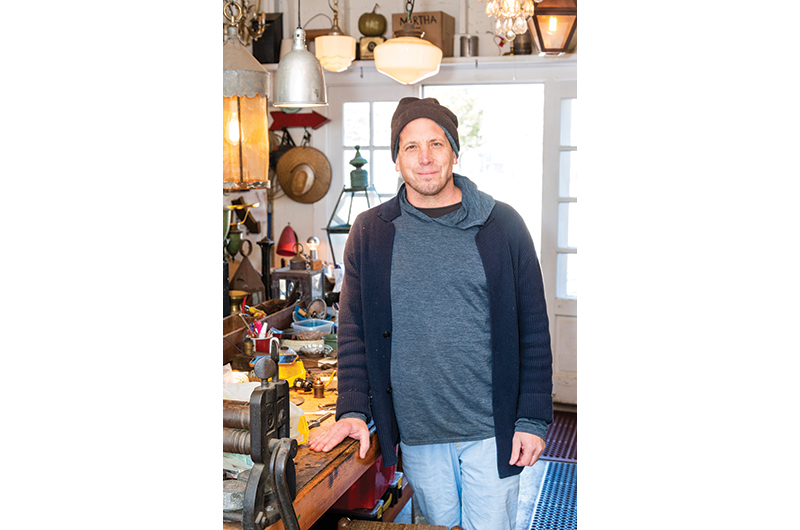Think of Billy Hoff, master craftsman and painter, as a preserver and interpreter of the Vineyard’s history.
As the maker of lamps and lanterns by hand, he sustains a tradition that Arthur H. Hayward, an expert in U.S. colonial lighting, dates from as early as 1690. Night watchmen in Boston kept iron fire baskets on the corners of frequented streets filled and burning. The first street lantern went up in Edgartown in February 1869. “Its rays will guide the pedestrians during dark evenings,” gushed the Vineyard Gazette, which urged voters at the next town meeting to consider erecting more lanterns.
In August 1894, Edgartown got its first electric light. But as late as the early 1900s, Martin Van Buren Norton was still stopping at the town’s oil-lamp street lanterns with horse and dray to remove the previous night’s used-up lamps and replace them. In 1912, Edgartown’s oil-lamp lanterns were chucked in the town dump and replaced with incandescent light bulbs.
But some fans of the old oil lamp saved them in attics and cellars and eventually restored them, decorating their yards. Hollis W. Fisher, an electrical contractor who suffered a crushed leg in an auto accident in 1967, found therapy in his cellar workshop restoring the old lanterns and reproducing classic nineteenth-century lanterns and lamps, fitting them with incandescent bulbs. The therapy turned into a business, Lamplighter Corner Inc. Hoff, who moved to the Vineyard in 2001 (“the stars aligned”), purchased Lamplighter Corner in 2007, after it had been owned by several other Islanders.
Hoff operates the business out of a fifteen-by-twenty-foot workshop at Middletown Nursery in West Tisbury, which is owned by his brother, John. He has no assistant at the workshop, just Daisy, his large, two-and-a-half-year-old white Kuvasz, who greets visitors with cheerful barks and tail wags. Hoff says his “bread and butter” is making in copper or brass the nine styles of street, ship, barn, and tavern lanterns, priced from $800 to $1,600, illustrated in a black-and-white brochure that dates from Fisher’s days. He requires a day or two to make each lantern. The triangular tavern lantern takes him the most time (its design, based on a lantern Fisher found in Pennsylvania, was used in taverns all along the eastern seaboard).
Hoff doesn’t advertise for business: “Everything is word of mouth.” He meets clients through builders and architects, such as Robert A. M. Stern of New York and Patrick Ahearn of Edgartown and Boston. Hoff made twenty-three identical exterior lights for a Stern client in the Hamptons. The bill: $33,000. Of Ahearn, who has worked on many homes in the Edgartown Historic District, he says: “My fixtures and Ahearn’s homes are a good match.”
As someone who has never made anything more complicated than a paper airplane, I marvel at Hoff’s ability to transform a sheet of copper – by cutting, scoring, folding, crimping, soldering, and riveting – into an elegant object that will likely last for generations. He uses traditional wrought-iron tools from Fisher’s workshop. Only his soldering iron and drill press have moving parts.
He also designs and creates lighting fixtures that make use of “really cool” sculptural objects. He opens chest drawers in his workshop to show me hundreds of found objects, from door knobs to a harmonica to the silver nameplate of his first car, a 1982 Volvo. Michael S. Smith, the interior designer for State Road Restaurant in West Tisbury, commissioned Hoff to make a hoop chandelier, tweaking Hoff’s idea to use a John Deere tractor rim that would reinforce the notion of the restaurant’s food being locally sourced. Hoff is currently making eight contemporary exterior lights for a Menemsha home.
Hoff can count only five American makers of lamps and lanterns by hand. Hand-making them may seem to some like an outdated craft, what fellow craftsman Peter Korn calls in Why We Make Things and Why It Matters: The Education of a Craftsman (Godine, 2015), “a decidedly marginal occupation [today] – economically, socially, technologically, and culturally.” It’s certainly not a way to make a fast million.
But Hoff loves what he does. After “bouncing around the country,” assisting a New York lamp designer, and working in landscaping, he has chosen, in an age of discount-store disposables, to make quality products by hand.
In the evenings and on weekends, Hoff paints. His oil paintings (one art critic called them “inscrutable images, ambiguous, dreamlike”) have been exhibited at the A Gallery and the Martha’s Vineyard Playhouse. The walls of his workshop display three five-foot-by-seven-foot paintings, one he started in graduate school (he earned a bachelor of fine arts from Ithaca College in New York and a master of fine arts from the Art Institute of Chicago). He isn’t sure he’ll ever figure out the painting: “Maybe I’ll never get to that point.” Then he jokes, “It’s the journey, man.”
At fifty-five years old, Hoff is not yet sure where that journey will take him and Lamplighter Corner. He and his wife, Amy, have two daughters, Chloe, who is in college, and Hannah, a senior in high school. Hoff doubts that either daughter will want to take over his lamp-and-lantern business. Perhaps, he says, the sons of his brother will become interested.





